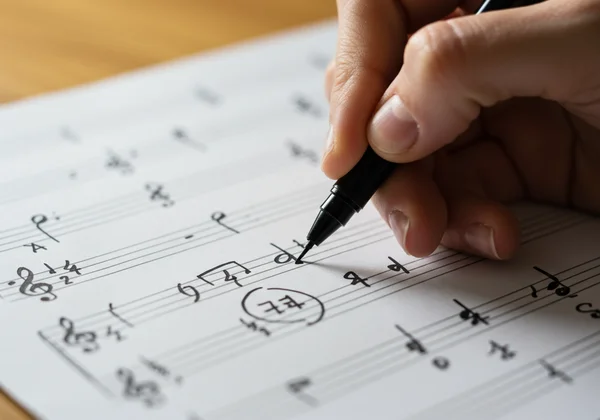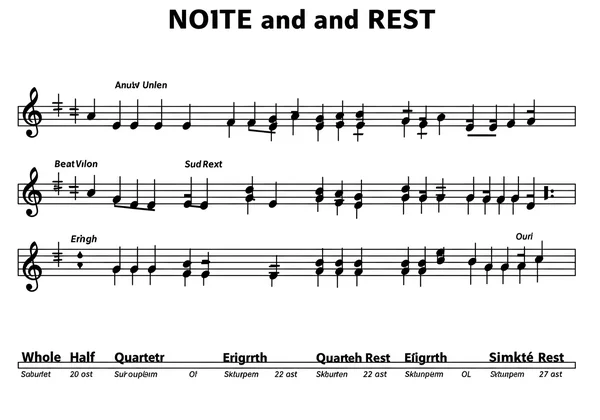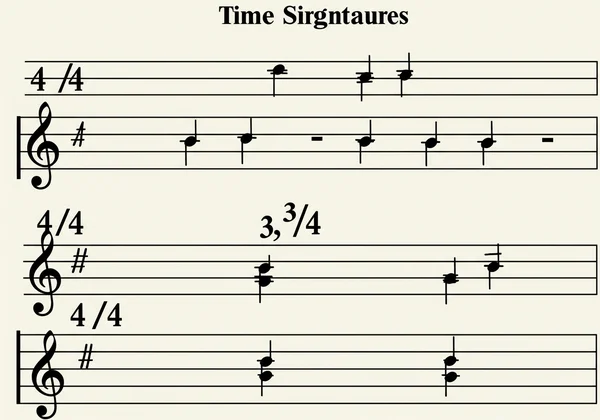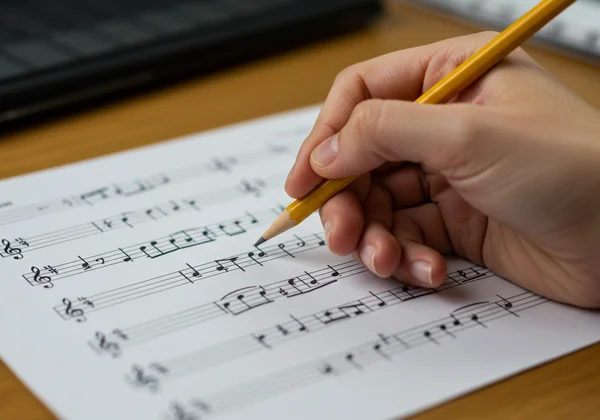Master Rhythm on Staff Paper: Notes & Time Signatures
Demystifying musical rhythm has never been easier! If you've ever felt intimidated by writing notes or understanding time signatures, you're in the right place. This guide will demystify rhythmic notation, showing you how to accurately express musical ideas using the essential tool of every musician: staff paper. But how to make your own staff paper that perfectly fits your practice needs?
This comprehensive guide will show you not only how to read and write rhythm but also how to get the perfect canvas for your creations. Get ready to transform your musical understanding and composition skills with practical examples, all perfectly suited for the free, printable staff paper you can generate instantly. Ready to transform your understanding and start composing with confidence?

Understanding Note Values & Rests on Staff Paper
Before you can write a soaring melody, you must grasp its pulse. Rhythm is the heartbeat of music, and it’s communicated through note values and rests. These symbols tell a musician how long to hold a sound or how long to remain silent. Using a clean sheet of manuscript paper is the first step to mastering this language.
The Foundation: Whole, Half, and Quarter Notes
Think of note values as a family tree. At the top, you have the longest standard duration, which is the foundation for all other rhythms.
- Whole Note (o): This is an open oval with no stem. In most common time signatures, it lasts for four beats. It’s the matriarch of our note family.
- Half Note (♩ with an open notehead): A whole note cut in half. It has an open notehead with a stem and lasts for two beats. You can fit two half notes into the space of one whole note.
- Quarter Note (♩): A half note cut in half. It has a filled-in notehead with a stem and lasts for one beat. This is often the basic pulse you tap your foot to in a song.
Understanding this simple hierarchy is the first key to writing rhythm. Grab some blank music staff paper and practice drawing these notes to get a feel for them.
Deciphering Musical Silence: Rests and Their Values
Music is as much about the silence between notes as it is about the notes themselves. Every note value has a corresponding rest, indicating a duration of silence.
- Whole Rest: A small rectangle hanging from the fourth line of the staff. It represents four beats of silence.
- Half Rest: A small rectangle sitting on top of the third line. It signifies two beats of silence.
- Quarter Rest: A squiggly, lightning-bolt shape. It calls for one beat of silence.
Great composers use rests to create tension, add emphasis, and give music its breathing room. When you're practicing, don't just write notes; strategically place rests to make your rhythms more interesting.
Faster Rhythms: Eighths, Sixteenths, and Beyond
To add speed and complexity, we continue dividing our notes. This is where music gets exciting and dynamic.
- Eighth Note (♪): A quarter note divided in two. It has a filled notehead, a stem, and one flag. Two eighth notes equal one beat. When written together, their flags are often connected by a beam.
- Sixteenth Note (♬): An eighth note divided in two. It has two flags (or two beams when grouped). Four sixteenth notes equal one beat.
You can continue this division into 32nd notes and beyond, but mastering these core durations will give you the tools to write and understand the vast majority of music you’ll encounter.

Mastering Time Signatures with Blank Sheet Music
Now that you know the different rhythmic puzzle pieces, the time signature provides the box lid—it tells you how those pieces fit together. Found at the beginning of a piece of music, a time signature is a fraction that organizes the beats into regular patterns called measures or bars, which are separated by vertical bar lines on the blank sheet music.
What Do the Numbers Mean? Explaining Common Time Signatures
A time signature contains two numbers stacked on top of each other. Each number has a specific job:
- Top Number: Tells you how many beats are in each measure.
- Bottom Number: Tells you what kind of note gets one beat. (4 = Quarter Note, 2 = Half Note, 8 = Eighth Note).
Let’s look at the most common ones:
-
4/4 (Common Time): The most popular time signature. It means there are four beats per measure, and the quarter note gets one beat.
-
3/4 (Waltz Time): Three beats per measure, with the quarter note getting one beat. Think of a classic waltz: ONE-two-three, ONE-two-three.
-
2/4 (March Time): Two beats per measure, with the quarter note getting one beat. It has a strong ONE-two feel, like a march.

Counting Rhythm: Practical Approaches for Any Meter
The key to playing rhythms correctly is learning to count them steadily. For rhythms involving eighth notes, a common technique is to subdivide the beat by adding "and" (&).
In 4/4 time, you would count a full measure of eighth notes as: "1 & 2 & 3 & 4 &". This simple method helps you place each note precisely where it belongs within the beat, creating a solid foundation for your rhythmic skills.
Beyond the Basics: Exploring Compound & Asymmetrical Meters
Once you're comfortable with simple meters, you'll encounter more complex ones. Compound meters, like 6/8, have a beat that divides into three parts instead of two, giving the music a flowing, triple feel. Asymmetrical meters, like 5/4 or 7/8, create unique and unpredictable rhythmic patterns by combining groups of two and three. Exploring these requires flexible and reliable tools, which is why having access to a good staff paper generator is invaluable for any growing musician.
Practical Exercises: Writing Rhythm on Your Staff Paper PDF
Theory is great, but music is a practical art. The best way to internalize these concepts is to put pencil to paper. The customizable staff paper PDF available here is the perfect resource for this, as you can tailor it to any exercise.

Step-by-Step: Notating Simple Rhythmic Patterns
Let’s start with a simple task. First, download your manuscript paper with a treble clef and 12 staves.
- Set the time signature to 4/4.
- In the first measure, write four quarter notes. Count them out loud: "1, 2, 3, 4."
- In the second measure, write two half notes. Count them: "1-2, 3-4."
- In the third measure, mix it up: one half note followed by two quarter notes. Count: "1-2, 3, 4."
- In the fourth measure, try one quarter note, one quarter rest, and two more quarter notes. Count: "1, 2 (silent), 3, 4."
This simple exercise helps you connect what you see on the page with how it sounds.
Rhythmic Dictation and Composition Drills
To sharpen your skills, try rhythmic dictation. Ask a friend to clap a simple, one-measure rhythm in 4/4 time. Your job is to listen carefully and write down what you heard on your staff notation paper. This drill helps you train your ear and solidify your understanding of musical notation.
Next, try composing your own rhythms. Challenge yourself to create a four-measure rhythmic phrase. Does it feel complete? Does it have a good flow? This is the first step toward writing your own music.
Maximizing Your Customizable Templates for Rhythm Practice
The real power of our free tool lies in its customization.
- Need more room for complex rhythms? Generate a page with fewer staves, like 8 per page, for more vertical space.
- Teaching a percussion class? Select the percussion clef template to create professional-looking exercises for your students.
- Writing for piano? The Grand Staff template is ready for you, allowing you to notate rhythms for both hands simultaneously.
Don't let a one-size-fits-all notebook limit your practice. You can customize your templates to create the perfect worksheet for any rhythmic challenge you want to tackle.
Putting Rhythm into Practice: Your Musical Canvas Awaits
Understanding music rhythm isn't an uncrackable code; it's a language built on simple, logical blocks. By learning note values, decoding time signatures, and putting your knowledge into practice, you’ve taken a massive step toward musical fluency. You now have the foundational skills to read, write, and create with confidence.
Knowing the theory is one thing; making music is another. The real magic happens when you practice, and with the right tools, it's easier than ever. Visit StaffPaper.org to download unlimited, free, and fully customizable manuscript paper. Start filling those pages with your own rhythms and bring your musical ideas to life today.
FAQ Section
How many lines are on staff paper?
Standard staff paper, also known as a stave, has five horizontal lines and four spaces. Each line and space represents a different musical pitch. For instruments with a wide range, like the piano, two staves are often joined together to form a Grand Staff.
What is staff paper called?
Staff paper is also commonly referred to as manuscript paper, music paper, or staff notation paper. All these terms describe pre-lined paper used by musicians to write musical notation by hand.
Where can I get free staff paper for rhythm exercises?
You can get unlimited, high-quality, and free staff paper directly from our site. It is a powerful tool that allows you to instantly generate and download a staff paper PDF tailored to your needs, whether it's for piano, guitar, choir, or simple rhythmic exercises.
What is the best paper for sheet music practice?
The best paper is one that suits your specific task. For jotting down quick ideas, a standard 12-stave layout is great. For composing for an orchestra or teaching, you might need more space between staves. The ideal solution is a resource like our online tool, where you can get your free paper in any format you need, instantly.
Can I customize staff paper for specific rhythmic drills?
Absolutely. Customization is essential for targeted practice. Using our tool, you can choose the clef (or no clef for rhythm-only drills), the number of staves per page, and the paper size (A4 or Letter). This allows you to create the perfect worksheet for any rhythmic drill or composition exercise.